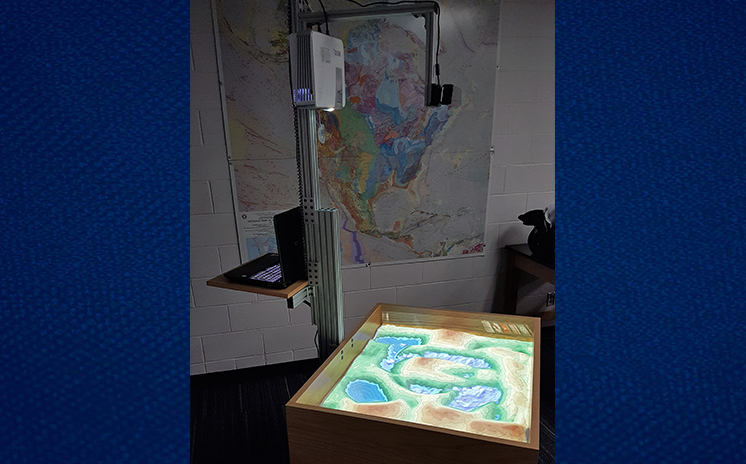We now have a running joke in the Science Building that my students play in the sandbox to learn Geology.
Well, yes, I guess we do. But it’s a very special augmented reality sandbox, one of only a handful in Texas that consists of a hands-on exhibit combined with 3-D visualization applications created by researchers at the University of California at Davis. One simply molds the sand by hand and the landscape comes to life. The sand is augmented in real-time with an elevation color map, topographic contour lines and simulated water.
 This new augmented reality technology shows our students what the topographic relief is on the earth’s surface. It is live and interactive so the students can change the surface and immediately see the impact on the topography. It takes learning about the earth to a whole new level because the students aren’t learning on a flat picture or book page, or even from a video. This is real, live and touchable science for them that shows the impact of the changes they make as they occur. So a mountain can change to a valley with the swipe of your hand and the students can see where the water goes and how that affects the area.
This new augmented reality technology shows our students what the topographic relief is on the earth’s surface. It is live and interactive so the students can change the surface and immediately see the impact on the topography. It takes learning about the earth to a whole new level because the students aren’t learning on a flat picture or book page, or even from a video. This is real, live and touchable science for them that shows the impact of the changes they make as they occur. So a mountain can change to a valley with the swipe of your hand and the students can see where the water goes and how that affects the area.
Science is relying more and more on high-tech equipment for the work that we do. And the learning environment should be no different. We wanted some new and innovative technology in the classroom even though it is also a lab.
When TCC South President Peter Jordan asked, “If you could ask for something new in terms of technology for this lab what would it be?” I did a little research and found this. I didn’t actually think he would say yes … and then he did.
To house the sandbox, we renovated a classroom into a science lab for multiple geology classes. I believe it can be used in many different ways. We can teach students about glaciers, rivers, topography, the water cycle, environments, climate, coastal geology, and many other topics.
We purchased the sandbox based on the design created by research at UC Davis that was originally generated for a National Science Foundation grant at the university for cave research. More information is available at https://arsandbox.ucdavis.edu/.
— Stacey Metzler, Department Chair, Physical Sciences

